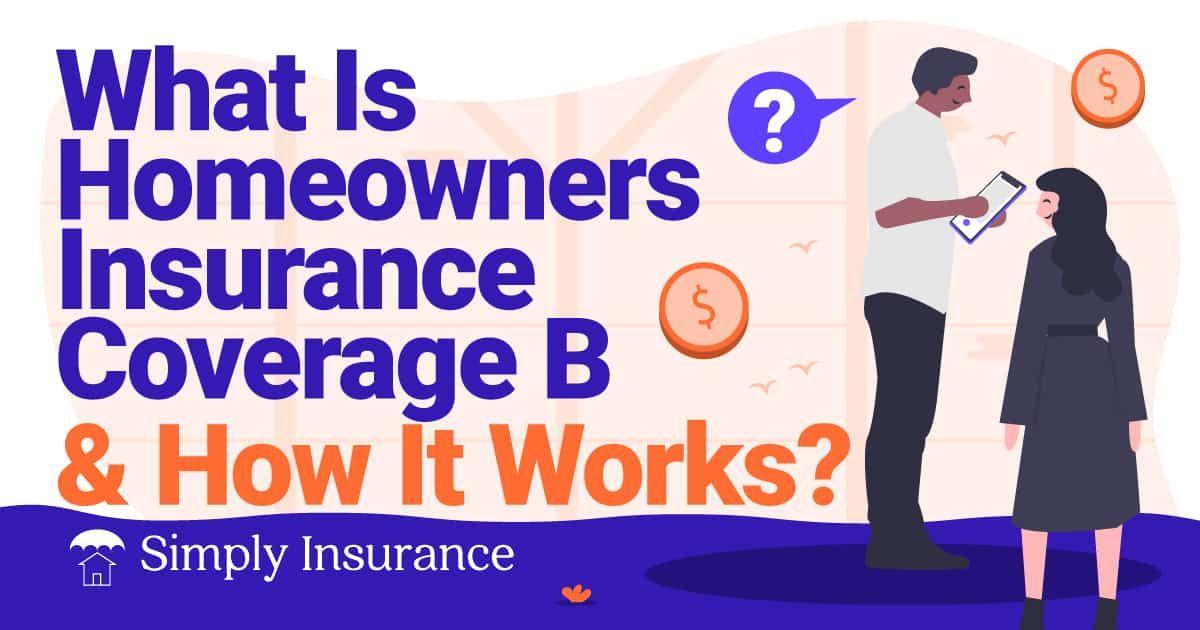To purchase Coverage B or not to purchase B, that is the question of the day.
If you’re a homeowner, you’re probably asking yourself what is homeowner’s insurance with Coverage B or Do I need coverage b home insurance?

In this post today we will help you decide if you need home insurance coverage B, what coverage b actually protects and how much coverage you may need.
What Is Homeowner’s Insurance Coverage B?
Homeowner’s insurance has multiple categories that protect different parts of your property.
Some are mandatory, and some are not; the variation gives you flexibility when designing your insurance policy your policy.
Here is a rundown of all six categories:
Homeowner’s insurance Coverage B is sometimes known as other structures coverage. It’s your last line of defense when protecting property that is not the home itself.
Many insurance providers charge 10% of your dwelling coverage for the policy.
THE SIMPLY INSURANCE WAY
Home Insurance made easy.
Agents not required.
Get quotes and sign up online without talking to an agent. But, we are here if you need us.
Unbiased, expert advice.
Get unbiased insurance education from licensed experts and also avoid dodgy sales calls.
Coverage in minutes.
You can get Home insurance coverage within minutes of getting your quotes and applying.
How Does Coverage B Work?
Coverage B protects any structure on your property that is not the home. For instance, a fire may burn down your guesthouse.
After you pay the deductible, the insurance company will provide you the money to replace it.
The amount of money you receive depends on the guesthouse’s value and your policy limits.
If you have a $20,000 limit and the $2,000 shed is a total loss, you’ll receive compensation in full.
If it’s a $30,000 guesthouse, the insurer will only pay up to $20,000, and you’ll have to fund the rest out of pocket to replace it.
Coverage B applies to a wide range of named perils, including theft, vandalism, wind, and hail. It does not cover everything, most notably earthquakes and floods.
You'll need to purchase a separate insurance policy if you want to protect structures from either of these natural disasters.
What’s Considered an “Other Structure?”
The definition of an “other structure” depends on how you use your property.
For instance, if you run a gardening business out of your backyard, Coverage B probably won’t cover your greenhouse, plants, or equipment.
As a rule of thumb, most insurance companies consider an “other structure” an object for residential or leisurely use, including:
Note that insurance companies differentiate between in-ground and above-ground pools for coverage purposes.
Most in-ground pools fall under the insurance policy’s dwelling provision, otherwise known as Coverage A.
Above-ground pools fall under personal property, which makes them part of Coverage C.
What Does Other Structures Insurance Cover?
Coverage B protects structures from named perils, which are specific hazards.
You can purchase peril policies as an alternative to all-risk insurance, which covers hazards not explicitly mentioned in the insurance policy.
Some of the most common perils include:
- Damage from aircrafts
- Damage from cars
- Fire and smoke
- Lighting
- Vandalism
- Volcanoes
- Wind and hail
Note that earthquakes and floods are not on this list. Most Coverage B policies also do not protect homeowners from pests, gradual water damage, and wear and tear.
You are responsible for replacing or repairing the other structures out of pocket if you incur these damages.
Make sure you understand the compensation structure before agreeing to the terms and conditions.
Most insurers offer full replacement costs to replace or repairs the items instead of the actual cash value.
Replacement cost is the same as receiving a comparable structure without accounting for depreciation.
Some insurance providers flip the terms based on the structure. For instance, you may receive a replacement cost for your shed, but actual cash value for your mailbox.
Again, read the policy to see if you need to alter the reimbursement structure.
HOME INSURANCE WHERE YOU LIVE
Home insurance by state.
Protecting your new home should be a top priority.
Click on your state to get a free home insurance quote and make sure that you're fully protected.
What Does It Not Cover?
Coverage B insures many of the structures you find in your yard.
Coverage A and Coverage C protect things that are inside the home.
There are always exceptions to the rule, as noted in the pool example.

Coverage A is also known as “dwelling coverage.” It reimburses you for repairs or replacements related to your home’s structure.
That includes the foundation, walls, support beams, roof, and windows.
Coverage C applies to your personal belongings. Expect a check in the mail if someone steals or ruins your clothing, electronics, or furniture.
Coverage C does not cover all your possessions, including many high-value items.
How Much Other Structures Coverage Should You Have?
There are no hard and fast rules when it comes to buying or pricing other structures insurance. Most insurance providers set it to 10% of your dwelling coverage.
If you have $200,000 in dwelling coverage, you’ll have $20,000 in protection for your structures.
If 10% is not enough, you can increase your coverage limit. Some insurance providers let you upgrade your reimbursement provisions beyond the replacement cost.
Thus, if someone damages a structure to the point of a total loss, you’ll receive a check greater than the structure value.
Take Action
So, do you need other structures coverage (Coverage B)? The truth is that it’s not mandatory, but it is nice to have.
Most home insurance policies today will come with Other structures coverage, but you should always ask before you purchase the policy. It protects most of the objects in your yard from peril, including your deck, mailbox, and guesthouse.
If you don't have home insurance you are putting yourself at huge risk, you can click here or on any of the above buttons to get a free quote and instant coverage.
